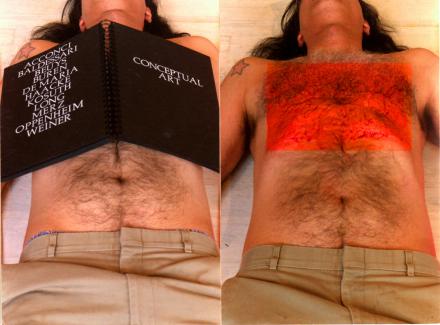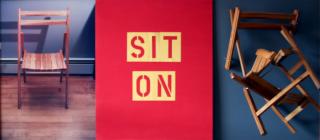
Faux Content
Show-in-a-Box
Looking at Four Works

The process of picking up the threads of a project from 14 year ago, Faux Conceptual Art, is quite interesting. I’ve been framing the works, re-photographing them and creating new pieces. Looking at four works I see similar themes and ideas emerging. The pieces, Fibonacci Series With Calculators, Sit On, Price List and Not Here, have never been exhibited other than being presented on the web. This is a very strange idea. The whole web site, Faux Conceptual Art is a work that is a proposition. It is also in some measure a critique of the art market. Since re-engaging the works I am plodding along at a leisurely rate like a sort of anthropologist trying to piece together what I was thinking. This becomes fairly interesting because the world has changed, art discourse has advanced, and I have gone through many stages in that time.
READING POSITION FOR A SECOND DEGREE BURN - 1970 - re-staged in 1993 - updated in 2007
 Oppenheim Sunburn Remix -1993
Oppenheim Sunburn Remix -1993
I’m looking at the works I did fourteen years ago to understand what I was trying to get at. The works were done as I was beginning to work with the internet. One of the web sites I created was called Faux Conceptual Art. I was thinking about the burgeoning business of counterfeit products such as watches and designer label products coming from China. Since I live a few blocks from Canal Street in New York, I am aware of all the counterfeit products being sold on the street. I thought that the fakes were a very interesting by product of globalism. They also functioned as a linguistic game. The game is about a shift in the idea of creativity. It also extends the 1980’s discussion of appropriation into the 1990’s debate about intellectual property. The shift in creativity is subtle. This also has it’s basis in the famous essay by Walter Benjamin, Art In The Age of Mechanical Reproduction. What Benjamin says is that art loses its’ “aura” when it is reproduced. The discussion is about the qualities of an artwork. This presupposes that art is about a unique object, a masterwork. The copy supposedly has no “aura.” What conveys uniqueness or the quality of art to an artwork? This becomes a central question for every generation of artists.
Re-Staging, Re-Enactment, Remix and Mimetics
 I called this piece 3-In-1 done in 1994, a fake Joseph Kosuth. Actually it was a restaging of the Kosuth piece that put the three separate elements (photo, chair, Photostat) into a frame making it into a single discreet art object. The original piece by Kosuth titled, One In Three Chairs has three separate parts.
I called this piece 3-In-1 done in 1994, a fake Joseph Kosuth. Actually it was a restaging of the Kosuth piece that put the three separate elements (photo, chair, Photostat) into a frame making it into a single discreet art object. The original piece by Kosuth titled, One In Three Chairs has three separate parts.
_Memory_Podd Inc_
____________________________________
MemoryPodd BETA software [MEMEPODD] creates a user-defined reality version of memory construct files (*.podd) in avatar_compatible models (Tars). Later versions of MEMEPODD are expected to have different reality_layer_field_encoding with AI geared towards autonomy rather re-creation. convertoutpodd is a command line utility to convert *.podd files created with MEMEPODD to TAR manifestations that correspond exactly with a users desired model.

